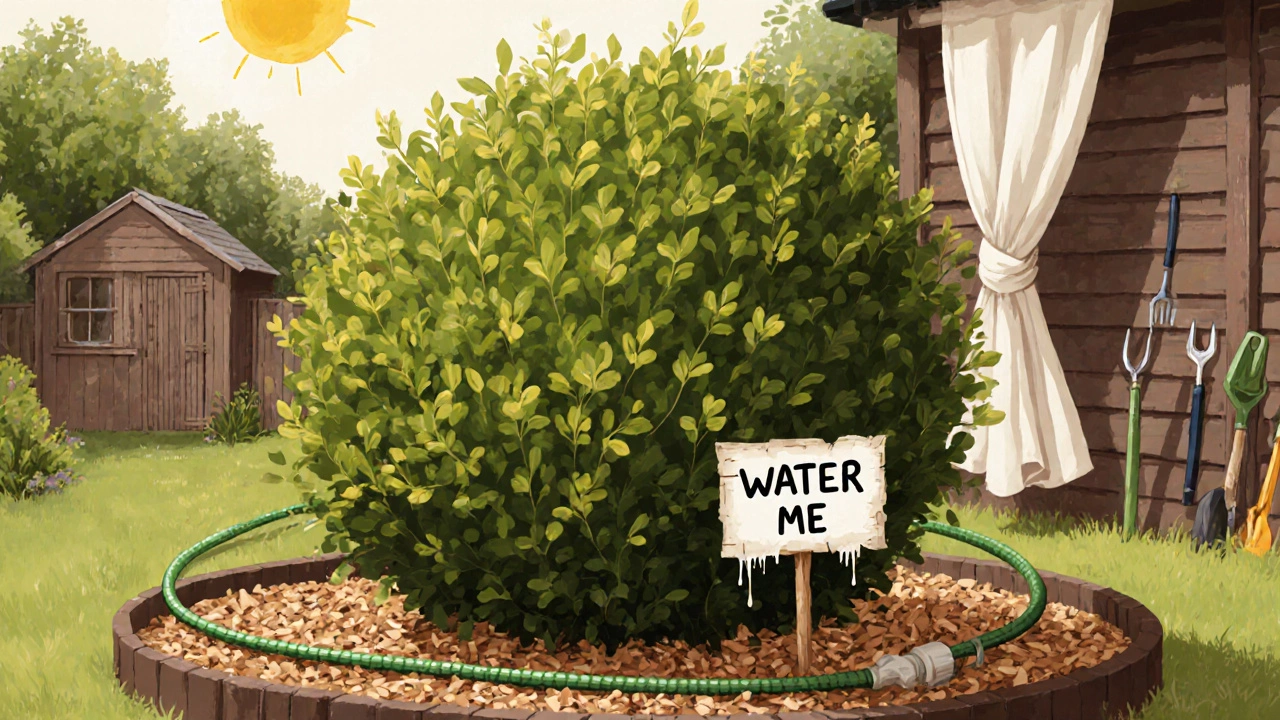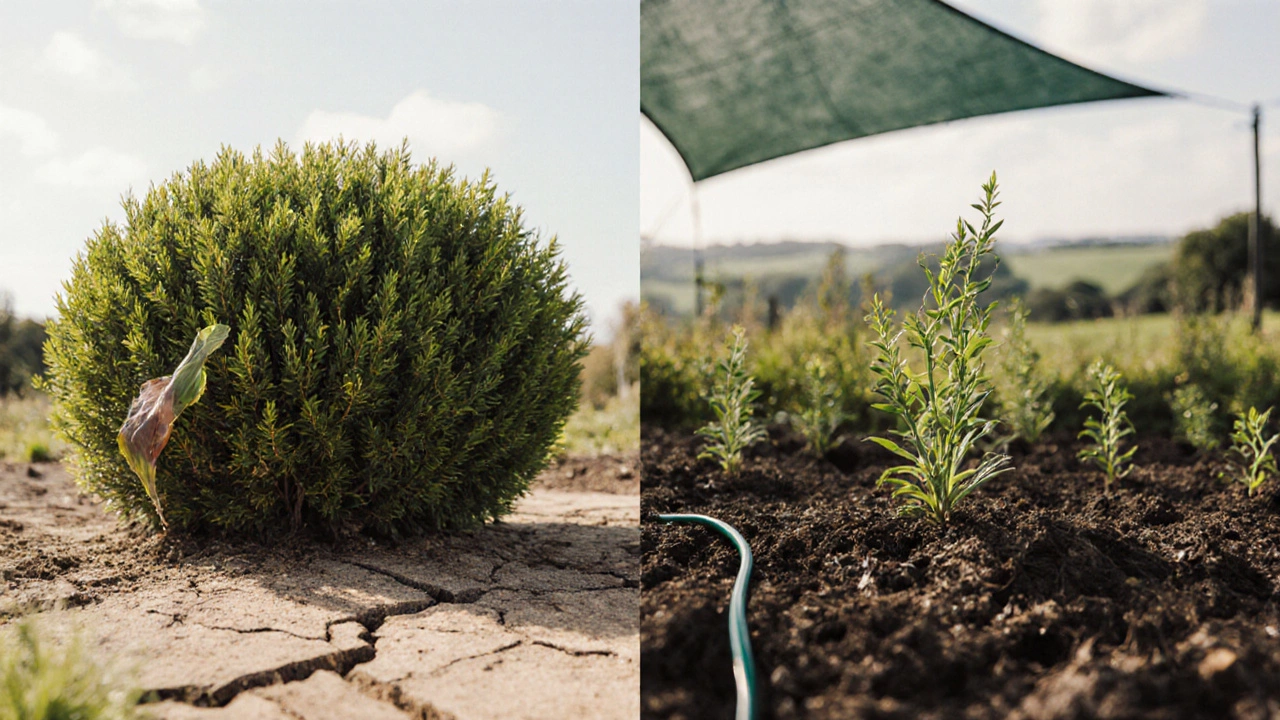Shrub Watering Calculator
Calculate Your Shrub's Watering Needs
Determine the exact amount of water your summer-planted shrub needs based on size, soil type, and days since planting. Proper watering is critical for summer success.
Watering Recommendations
Recommended Water Amount: 5-10 litres per shrub
Watering Frequency: Every 2-3 days
Water needs decrease after 6 weeks as roots establish. For shrubs planted more than 6 weeks ago, reduce water by 25%.
You’ve got your favourite shrubs picked out-maybe a glossy viburnum, a tough boxwood, or a flowering hydrangea. The nursery has them in stock, the weather’s warm, and you’re ready to dig. But then you pause: can you plant shrubs all summer? The short answer? Yes, you can. But whether you should depends on how you do it.
Summer planting isn’t forbidden-it’s just riskier
In the UK, the traditional planting window for shrubs runs from late autumn to early spring. That’s when the soil is still warm from summer but the air is cool, and plants can focus on growing roots before the next heatwave. But that doesn’t mean summer planting is a no-go. Many gardeners successfully plant shrubs in June, July, and even August. The difference? It takes more work.
Shrubs planted in summer are under stress. High temperatures, dry soil, and long daylight hours mean they’re losing water faster than they can take it up. Their roots haven’t had time to spread out yet, so they can’t reach deeper moisture. Without extra help, they’ll wilt, drop leaves, or worse-die back.
Which shrubs handle summer planting best?
Not all shrubs are equal when it comes to summer stress. Some are built for it. These are your safest bets:
- Boxwood (Buxus) - Tough, slow-growing, and forgiving. Handles heat well if watered regularly.
- Hebe - Native to New Zealand, it thrives in warm, sunny spots and recovers quickly from transplant shock.
- Hydrangea paniculata - Especially the newer varieties like ‘Limelight’ or ‘Pinky Winky’. They root fast and bloom even when planted midsummer.
- Photinia red robin - Grows aggressively. If you give it water, it’ll bounce back fast.
- Euonymus fortunei - A ground-hugging evergreen that’s practically indestructible in summer if kept moist.
Avoid planting large, slow-growing shrubs like Yew or Laurel in summer unless you’re prepared to water daily for months. Their root systems take too long to establish, and summer heat can kill them before they get started.
How to plant shrubs in summer-step by step
If you’re set on planting now, follow these steps to give your shrubs the best shot:
- Choose the right time of day - Plant in the evening or on a cloudy day. Avoid midday sun. Cooler temperatures mean less shock.
- Soak the root ball - Leave the shrub in its pot in a bucket of water for 30 minutes before planting. Wet roots = better survival.
- Dig a wide, shallow hole - Make it twice as wide as the root ball but no deeper. You want roots to spread out, not sink.
- Use native soil, not compost - Mixing in lots of organic matter can trap water and cause rot. Just loosen the soil around the edges so roots can move out.
- Plant at the same depth - The top of the root ball should sit level with the soil surface. Burying it too deep invites rot.
- Water deeply right away - Give it at least 5 litres of water immediately after planting. Don’t just sprinkle-it needs to soak down to the roots.
- Mulch thickly - Spread a 5-7 cm layer of wood chips or bark mulch around the base. This keeps the soil cool and cuts evaporation by up to 70%.
Watering is everything
After planting, your shrub will need water like it’s on a drip feed. For the first 4-6 weeks, give it 5-10 litres every 2-3 days. That’s not a quick hose spray-it’s a slow soak at the base. Use a watering can or a hose with a gentle flow.
Check the soil every morning. Stick your finger 5 cm down. If it’s dry, water. If it’s damp, wait. Overwatering is just as dangerous as underwatering. Wet soil in summer can suffocate roots.
Consider using a simple drip irrigation system or a water-retaining gel around the root ball. These aren’t fancy-they’re survival tools.

Shade and wind protection
If your planting spot gets full sun all day, especially in southern England, give your new shrub some temporary help. Prop up a piece of garden fleece or an old curtain on stakes to create shade during the hottest hours-11am to 4pm. Even 30% shade can make a huge difference.
Wind is another killer. Dry, hot winds pull moisture out of leaves faster than roots can replace it. A windbreak-like a temporary fence made of bamboo or burlap-can cut wind speed and reduce stress.
What to expect after planting
Your shrub might look miserable for a few weeks. Leaves may yellow, curl, or drop. That’s normal. It’s not dead-it’s conserving energy. Don’t panic. Don’t fertilise. Don’t prune. Just keep watering.
By late August or early September, you should see new growth. Tiny buds, fresh leaves, maybe even a few flowers. That’s your sign the roots are finally settling in. If nothing happens by October, it’s likely lost.
Why autumn is still the best time
Even if you pull off summer planting, autumn is better. From late September to November, the soil is still warm from summer, but the air is cooling. Rain becomes more regular. The shrub focuses on root growth without the pressure of producing leaves or flowers.
By spring, a shrub planted in autumn has a root system that’s already 2-3 times larger than one planted in summer. That means it handles drought, wind, and heat much better. It’s less work for you, and the plant thrives.

What to do if you missed autumn
If you didn’t plant in autumn and now it’s summer? You’re not out of options. You can still plant-but treat it like an emergency rescue mission. Focus on the tough shrubs. Water like your garden depends on it. Mulch heavily. Give shade. And accept that you’re playing a high-stakes game.
Or, wait. Buy your shrubs now, keep them in their pots in a shaded spot, water them daily, and plant them in October. That’s often the smarter move. Nurseries stock shrubs year-round for a reason-they know people will buy them. But they don’t expect you to plant them right away.
Common mistakes to avoid
- Planting in hot, dry soil - Always water the hole before putting the shrub in.
- Using too much compost - It holds water too well and can rot roots in summer heat.
- Skipping mulch - Mulch is your best friend in summer planting. Don’t skip it.
- Assuming rain will save you - UK summer rain is unpredictable. Don’t rely on it.
- Feeding too soon - Fertiliser burns stressed roots. Wait until spring.
Final verdict: Yes, but...
You can plant shrubs all summer in the UK. But you shouldn’t do it unless you have to. If you’re replacing a dead shrub, or you found a rare plant on sale, go ahead-but treat it like a hospital patient. Water, shade, mulch, patience.
But if you’re planning ahead? Wait until October. You’ll save time, money, and heartache. Your shrubs will thank you with years of healthy growth.
Can I plant shrubs in July in the UK?
Yes, you can plant shrubs in July, but only if you’re prepared to water them deeply every 2-3 days for at least 6 weeks. Choose heat-tolerant varieties like Hebe, Hydrangea paniculata, or Boxwood. Avoid large, slow-growing shrubs like Yew or Laurel. Mulch heavily and plant in the evening or on a cloudy day.
Is it better to plant shrubs in spring or summer?
Spring is better than summer, but autumn is best. Spring planting gives shrubs time to establish before summer heat. Summer planting forces them to fight heat and drought while trying to root. Autumn planting lets them grow roots in warm soil without the stress of hot air or full sun-leading to stronger, healthier plants by next spring.
Do I need to water shrubs every day in summer?
Not every day, but every 2-3 days is essential for the first 6 weeks after planting. Use 5-10 litres per shrub, soaked slowly at the base. Check the soil with your finger-if it’s dry 5 cm down, water. Rain doesn’t count if it’s light or spotty. Consistent moisture is key.
Can I plant shrubs in pots during summer?
Yes, planting shrubs in pots during summer is actually easier than planting in the ground. Pots dry out faster, but you have more control over watering. Use a large pot with drainage holes, high-quality potting mix, and place it in partial shade. Water daily in hot weather. You can move pots to shelter if a heatwave hits.
What happens if I plant a shrub in summer and forget to water?
If you forget to water a newly planted shrub in summer, it will likely die. Without consistent moisture, roots dry out and die. The plant may look fine for a few days, then suddenly drop all its leaves and turn brown. Once the roots are dead, it can’t recover-even if you start watering again. Prevention is the only cure.
